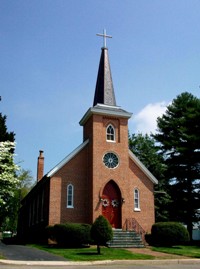We, the
faithful of
St. Rose of Lima Roman Catholic Church
A Mission Church of St. Joseph’s Parish,

Photo by Lewis Collins
Est. 1874
Sunday Worship
8:00 & 9:30 a.m.
Tuesday
Worship 8:30 a.m.
301 Lock
Street
North
Chesapeake City, MD
888-433-1874
 Saint
Rose of Lima, T.O.S.D., was a Spanish colonist in Lima, Peru, who became
known for both her life of severe asceticism and her care of the needy
of the city through her own private efforts. Saint Rose of Lima was a
beautiful girl who wanted to devote her life to God. To make herself
unattractive to men, she rubbed pepper on her face. She spent her life
in prayer and fasting, growing flowers to sell and help the poor. Her
parents did not allow her to become a nun. So St. Rose joined the Third
Order of St. Dominic instead, where she could continue to serve God at
home. She is the patron saint of florists and gardeners. Her Feast Day
is on 23 August.
Saint
Rose of Lima, T.O.S.D., was a Spanish colonist in Lima, Peru, who became
known for both her life of severe asceticism and her care of the needy
of the city through her own private efforts. Saint Rose of Lima was a
beautiful girl who wanted to devote her life to God. To make herself
unattractive to men, she rubbed pepper on her face. She spent her life
in prayer and fasting, growing flowers to sell and help the poor. Her
parents did not allow her to become a nun. So St. Rose joined the Third
Order of St. Dominic instead, where she could continue to serve God at
home. She is the patron saint of florists and gardeners. Her Feast Day
is on 23 August.
Born:
April 20, 1586,
Lima, Peru
Died: August 24, 1617,
Lima, Peru
CHESAPEAKE
CITY — The charming red-brick building in north Chesapeake City, known
as St. Rose of Lima, was built of Gothic design and when a cornerstone
as blessed there on Aug. 30, 1874, some 500 people were in the audience
for the auspicious occasion.
History does
not offer us information on how many people were attendance on June 20,
1875, when the church was completed and dedicated, but Catholics from
across Cecil County were invited to participate.
The Catholic
parishioners of Immaculate Conception Church in Elkton prepared dinner
for the festivities, and guests arrived in Chesapeake City aboard the
steamer Lancaster, picking up passengers en route from Port Deposit,
Perryville and Havre de Grace before landing at what became known as
Schaefer’s Dock on the canal for their first view of the church. The
Rev. Joseph Luke Barry, pastor of St. Patrick’s in Havre de Grace, sang
the Solemn High Mass, assisted by the Rev. O’Connor of St. Peter’s
Church in Baltimore and Father William Dallard of Immaculate Conception.
Many have
speculated, then and now, why the new Catholic Church in Chesapeake City
was named St. Rose of Lima. It was thought by historian and writer the
Rev. Russell H. Perkins that the name was selected because St. Rose was
the only native of the western hemisphere to have been canonized a
saint. In any event, St. Rose became a mission of St. Francis Xavier
located in Warwick.
After the
ceremony in 1875, it took more than a year for the deed to be recorded
in December 1876, and St. Rose of Lima was not turned over to Father
Dallard until Jan. 24, 1877, who was replaced in 1878 by Father Charles
H. Heichemer, S.J. The following year, on April 20, 1879, the Stations
of the Cross were installed and blessed at St. Rose of Lima under Father
Heichemer, who also performed the first baptism there, for a young
African-American boy named Francis Moore in August 1881. In 1880, Father
Heichemer also received John Lloyd into the church in June, performed
the marriage ceremony for John and Susan Moliter in September. Between
July 1879 and July 1880, he performed 14 funeral masses.
Over the
years, the congregation began to dwindle at nearby St. Francis Xavier’s
in Warwick so the Jesuit Fathers had a surveyor plat the property and
St. Francis Xavier’s was turned over to the diocese in July 1898. By
1905, with the Elkton congregation growing, St. Rose of Lima was placed
under Father Charles A. Crowley, a newly ordained pastor of Bohemia, the
third diocesan priest in charge of the parish since the departure of the
Jesuits (the previous diocesans being Fathers John Daly and Charles
McGoldrick).
Father
Crowley celebrated Mass at Middletown, Del., Chesapeake City and Bohemia
on alternating Sundays, with two hours by horse and wagon required to
get from Middletown to Chesapeake City. He would travel on Saturday
afternoons and stay with Joseph Schaefer’s family, and Mr. Schaefer
started the first in the church stoves before the congregation and
priest arrived Sunday.
As the
congregation of St. Rose of Lima was my no means large, but nonetheless
continuous, maintenance and improvements to the structure were paid for
through bazaars, pew rents and dues and funds raised by the ladies of
the “Sanctuary Society.” John A. McCloskey, a summer resident of
Chesapeake City, who hailed from Chester, Pa., contributed to having the
church painted and a rail added to the front steps. He also donated a
brass tabernacle door and a reed organ played by his daughter.
By 1927,
however, with the widening of the C&D Canal to 90 feet, Chesapeake City
ceased to be an important stop-over for ships, and St. Rose’s
congregation took a noticeable dip. By 1929, after the stock market
crash, times were difficult for the congregation and even the vaunted
St. Xavier Farm was sold off to a local farmer. The ladies of St. Rose’s
Church worked feverishly to raise funds through bingos and card parties
with prizes offered from donors in Wilmington and Philadelphia. Through
their strenuous efforts, the church survived the lean times.
On Jan. 19,
1955, the mission of St. Rose was independently incorporated in the
State of Maryland, to prepare the church for becoming a parish itself.
Two acres of land were acquired from the Sisters of Saint Basil the
Great on Feb. 28, 1955, after Carrie Wright left her home and $5,000 to
the mission, though it isn’t known if these funds went toward the
purchase.
Outside
influences changed things at St. Rose of Lima, but once again the
congregants overcame when construction on the bridge trapped the Rev.
John P. McLaughlin and others from reaching St. Rose for classes of
instruction. On Oct. 10, 1965, it was announced that Sunday School would
resume under three women who volunteered to teach classes after
receiving training. Still St. Rose of Lima thrived, and four years later
in 1969, Saturday evening Masses were instituted to alleviate crowding
at Sunday Mass. That year, a baptismal font was also added in the form
of the old font from Immaculate Conception in Elkton.
In 1973, the
interior of St. Rose of Lima was repainted and new carpet installed. The
Rosary Altar Society paid for the candelabra, vases and sacred vessels
to be refinished, and a statue of St. Rose was imported from Spain and
blessed with a special ceremony on the Feast of St. Rose. Other
necessary elements such as new walkways, parking lot, air conditioning
and a furnace were added. All of this was completed in time for the
church to celebrate its 100th anniversary on Oct. 6, 1975, with a Mass
followed by dinner and dancing at the former Madison House in North
East.
By the 21st
century, a 2000 census showed the number of registered families at St.
Rose of Lima had grown to 200.
